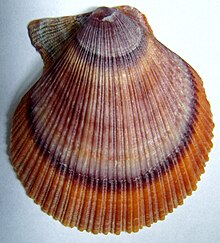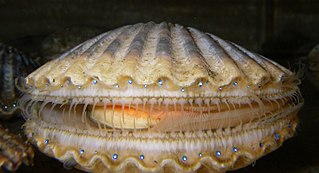
Scallop is a common name that encompasses various species of marine bivalve mollusks in the taxonomic family Pectinidae, the scallops. However, the common name "scallop" is also sometimes applied to species in other closely related families within the superfamily Pectinoidea, which also includes the thorny oysters.

The Ostreidae, the true oysters, include most species of molluscs commonly consumed as oysters. Pearl oysters are not true oysters, and belong to the order Pteriida.

Ampullariidae, whose members are commonly known as apple snails, is a family of large freshwater snails that includes the mystery snail species. They are aquatic gastropod mollusks with a gill and an operculum. These snails simultaneously have a gill and a lung as functional respiratory structures, which are separated by a division of the mantle cavity. This adaptation allows these animals to be amphibious. Species in this family are considered gonochoristic, meaning that each individual organism is either male or female.
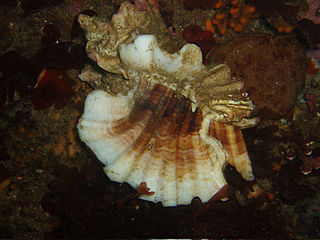
Ocenebrinae is a taxonomic subfamily of predatory sea snails, marine gastropod mollusks. This subfamily is within the large family Muricidae, which are commonly known as the murex and rock snails.
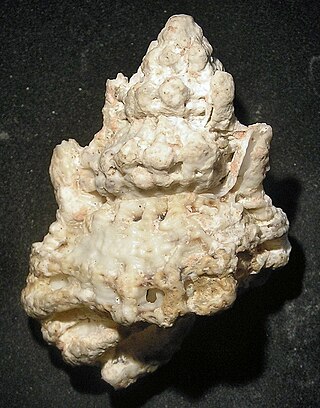
Bursa is a genus of large sea snails, marine gastropod molluscs in the family Bursidae, the frog snails or frog shells.
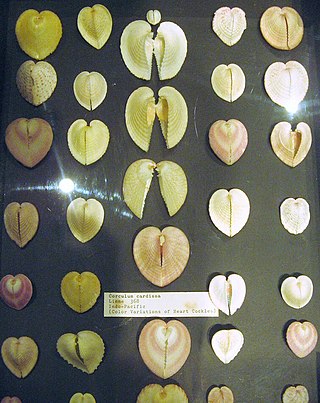
Corculum is a genus of small saltwater clams, marine bivalve molluscs in the family Cardiidae, the cockles. They maintain Symbiodinium dinoflagellates as symbionts.

Mimachlamys varia, also known under common names variegated scallop and black scallop, is a species of small scallop, a marine bivalve mollusk in the family Pectinidae, the scallops. It occurs in the North Sea, the English Channel, the eastern Atlantic Ocean, and the Mediterranean Sea.

Ellobiidae, common name the hollow-shelled snails, is a family of small air-breathing land snails, terrestrial pulmonate gastropod mollusks in the clade Eupulmonata. Ellobiidae is the only family in the superfamily Ellobioidea, according to the taxonomy of the Gastropoda by Bouchet & Rocroi, 2005).

Vasum, common name the vase snails or vase shells, is a genus of mostly rather large predatory sea snails, marine gastropod mollusks in the subfamily Vasinae within the family Turbinellidae.

Ficus is a genus of large sea snails, marine gastropod mollusks in the family Ficidae, the fig shells.

Angaria delphinus, common name the common delphinula, is a species of sea snail, a marine gastropod mollusc of the family Angariidae.

Euvola is a genus of marine bivalve mollusks in the family Pectinidae, the scallops. In shells of this genus, one valve is flat, and the other is deeply cupped.

Mimachlamys asperrima, common name the austral scallop, doughboy, doughboy scallop, fan shell, or prickly scallop, is a species of scallop, a marine bivalve mollusc in the family Pectinidae, the scallops.

Swiftopecten swifti, common name Swift's scallop, is a species of bivalve mollusc in the family Pectinidae. It occurs in the northern Pacific Ocean.

Nebularia is a genus of predatory sea snails, marine gastropod mollusks in the subfamily Cylindromitrinae within the family of Mitridae. This name was originally proposed as a subgenus of the genus Mitra. The type species of this genus is Mitra contractaSwainson, 1820.

Magallana bilineata, commonly known as the Philippine cupped oyster or slipper oyster, is an economically important species of true oyster found abundantly in the western Pacific Ocean, from the Philippines to Tonga and Fiji. In 2020 an exotic population was discovered in north-east Australia. They grow attached to hard objects in brackish shallow intertidal or subtidal waters, at depths of 0 to 300 metres. They are cultured extensively in the Philippines, where annual landings can range from 11,700 to 18,300 tons. They are known as talaba or talabang tsinelas in Filipino to distinguish them from talabang kukong kabayo

